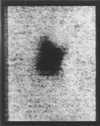|
C Magazine 14 Summer, 1987 |
|
| As Though We Knew What To Do | |
 Allan McCollum. Surrogates On Location. 1982 |
RONALD JONES
The world—and even the world of artists—is full of people who can go into the Louvre, walk rapidly, without so much as a glance, past rows of very interesting, though, secondary, pictures, to come to rapturous halt in front of a Titian or a Raphael—one of those that have been most popularized by the engravers art; then they will go home happy, not a few saying to themselves, I know my Museum. The cult of the personality is purposefully absent. In and of itself that is a frank admission to our cultural circumstances for, since the Renaissance, the artistic persona has been a currency of difference, the plasma of aesthetic exchange. Allan McCollum found it emptied out of meaning but chose to let its hopeless candor speak for itself. This was a judicious thing to have done, for in an era in which differentia is increasingly rare, but still taken for granted, McCollum has indelibly marked the discrepancy between the mythology of difference and its disappearance. His art suspends the chance to estimate value as an expression of the difference between creative personalities. Therefore, if only momentarily, the meaning of his art, its terms for cultural exchange, seem unfamiliar until a subtext, which has always been there, rises in relief. What comes to light is a profile of an art object prepared to be a candid witness to its own circumstances. No longer capable of conveying even discrete nuances of a personality, it is the agent for the social promotion of ideas, finance and prestige. McCollum has been enormously careful to screen his personality from his serial projects: the Surrogates, the Perfect Vehicles and the Perpetual Photos. To do otherwise would have entrapped him in the art-historical vice of periodicity which tightens around perceived changes in an artists mood or temperament; differences conveyed by the subtlest modulation in style. Expecting to discover changes of the heart like the ones between Picassos Blue and Rose periods no longer makes sense when chronology dissipates and history becomes archaic.
I'm interested in locating the meaning of my work—and the emotional content of my work—somewhere within those transactions which occur between the various someones who are involved in the artworks circulation. To do this I have to try to dislocate the objects so-called content. When we speak of a content as residing somehow within the art object, we disregard the object's meaning as an item in the real, social world, and replace this with all sorts of imaginary constructs.Emptied of content, unmarred by the artist's personality and free of history, McCollum's art is suspended within a perfectly inert atmosphere. His work holds itself against our culture unrestrained by the nominal references that traditionally ground works of art. And yet, it is their benign appearance that makes it certain they will never permit a neutral experience. Without warning, McCollum's art leaves us utterly alone to reflect on our motives for having sought it out, to contemplate the varying degrees of cultural best interests. Our delicate reactions unfold before us, unscathed by the prerogatives of art, uncovering the tracks of social exchange along the way. McCollum's art centres each of us deep within our own desires and alibis and then, excuses itself.
What is it we want from art that our belief in content works to hide from us?The Surrogates, each slight variations of an unseen but definitive prototype, are single cast forms portraying discrete black pictures, as if matted and within frames. Their relentless repetition is unforgiving to the luxury of aesthetic diversity. Bluntly, they are art reduced to the theory of commodity design. With the Surrogates before us, it is useful to reflect on an observation made by Jack Burnham in 1968:
A striking parallel exists between the new car of the automobile stylist and the syndrome of formalist invention in art, where discoveries are made through visual manipulation. Incredibly products—either in art or life—become irrelevant and a different set of needs arise: these revolve around such concerns as maintaining the biological livability of the Earth, producing more accurate models of social interaction, understanding the growing symbiosis in man-machine relationships, establishing priorities for the usage and conservation of natural resources, and defining alternative patterns of education, productivity and leisure. [1]In the way that commodification equalizes every experience, McCollum has evened out aesthetic sensation, devalued it by converging repetition, the loss of difference, and the absence of originality. That single gesture opens up other levels of meaning that art objects convey. As aesthetic reliquaries the Surrogates are virtually without interest, but as aesthetic products they map a field for potential discourse, a kind of tabula rasa prepared to substantiate extra-aesthetic meaning including social interaction. The plethora of Surrogates then, are not parodies, nor simulations, but symptoms. The relentlessly present absence of McCollum's art hinges it to a peculiarly unconventional strain of modern art history. Andy Warhol's film, Blow Job, 1964, Roy Lichtenstein's canvas, Big Painting, 1965, and Robert Barry's All the Things I Know..., 1969, are expressions of conspicuous absence: one a graphic sexual act, the next, the explicit residuals of emotional turmoil and finally the banality of personal knowledge. Each is an icon of an iconoclast, emblems of a freakish modern Platonism. McCollum's Perfect Vehicles similarly attempt to shadow an intangible subject: the Ideal, the proportions, the qualities of the perfect art object. [2] Each vase politely asks us to believe that it alone conveys the inexpressible.
Shouldn't I be able to isolate this signal, and reproduce it with the sparest of means? Then my objects could exist as pure potential, which no superfluous meaning or value other than that which they may accrue in relation to our aesthetic pleasure. Is it not my role as an artist to reproduce—and repeat at will—that psychic effervescence associated with the unrepeatable and perfectly unique timeless moment in which the rest of the world simply fades away ?The Perfect Vehicles are solid plaster casts that resemble Chinese ginger jars. They enfold the mystique of oriental design with the ruthless efficiency of occidental commodification. The result ushers out utility and difference to produce, to present, a faultless work of art. Manifest is the opportunity to invest in a metaphysical aura, the aroma of an aesthetic intoxicant. These solid vases, one following the other in endless procession, are designed to promote prestige. They are the stirring visions that redundantly confirm the economy of Ideal proportions. With the Ideal at stake, the unsayable but omnipresent rule of cultural authority, mere consumption and the value of the artistic persona seem suddenly inconsequential. Prestige, as I mean to apply it here, is roughly parallel to Jean Baudrillard's notion of aristocratic competition. He writes: Competition of the aristocratic sort seals their (the aristocratic class) parity (which has nothing to do with the formal equality of economic competition), and thus their collective caste privilege with respect to all others, from whom they are no longer separated merely by their purchasing power, but by the sumptuary and collective act of the production and exchange of sign value. [3] Cultural domination is therefore much less a matter of being able to afford to buy works of art and more about ones ability to dictate their production by transacting the value of cultural signs. It is a matter of being an arbiter of ideology. At the center of this power is not economic or cultural wealth but the influence that accompanies the prerogative to rearrange cultural values. Baudrillard continues:
Everywhere prestige haunts our industrial societies, whose bourgeois culture is never more than the phantom of aristocratic values. Everywhere the magic of the code, The magic of an elective and selective community, fused together by the same rules of the game and the same system of signs, is collectively reproduced, beyond economic value and on the basis of it. Everywhere this process comes to penetrate class conflicts, everywhere—diluted over the entire extent of society, whatever the economic status and class condition—it acts to the advantage of the dominant class. It is the keystone of domination. [4]McCollum's use of the ginger jar is a sly historical twist. As is well known, Europe's fascination with Chinese arts and crafts ultimately lead to their simulation as Western Chinoiserie. Not only did the European aristocracy invent new latitudes of occidental beauty that could accommodate their fetish for Chinese art, they successfully recast the original styles and practices of art in China. Some centuries ago, the European conception of what oriental art should look like overtook the existing styles, and Chinese artists and craftsmen were obliged to produce anomalies that would satisfy the European taste trade. With shrill irony a passage from McCollum's essay for the catalog of the Damaged Goods exhibition reads as though his voice has fallen in with some earlier cultural worker in China:
As an artist, I will repeat the signal, like a flashing beacon. I will rehearse my position, over and over, as a gesture to you, in and of itself. I will construct for you a world of fabulous substitutes for what is already a world of substitutes. I will muster the world for your review, and I will make you the object of the world's address. [5]That a measure of prestige is ones ability to arbitrate perfection centres the meaning of the Perfect Vehicles and betrays the witless terms and devastating effects of social exchange within our culture. Like the endless array of Surrogates and the idealized profile of the Perfect Vehicles, McCollum's Perpetual Photos draft a realm of experience existing beyond the ordinary. The photograph is a perfect visual record that transcends the physical limits of human sight. In a spirit of honest appraisal McCollum exploits photography, not to alter or disguise, but to totally reveal things otherwise unnoticed (in this respect, the Perpetual Photos may be viewed as a metaphorical expression of his art at large). The Perpetual Photos are, in a way, ready-made versions of the Surrogates, detected and uncovered within another dimension. They are the photographic renditions of pictures excised from television scenes. The original artists of these pictures will never be known. Their styles, once conductors of their personalities, have dissipated through serial rehearsals of the original, lost forever in the complex baffles of reproduction. Freed of their history, whatever it might have been, the Perpetual Photos have become the props of social exchange. They have been transferred from their previously discrete existence as televisions decor into the present tense with the expectation that we will know what to do with them now that they are actually here.
[1.] Jack Burnham, Great Western Salt Works: Essays on the Meaning of Post-Formalist Art, George Braziller, New York, 1974, pp. 15-16. [2.] In his catalog essay "Perfect Vehicles" which appeared in the catalog Damaged Goods: Desire and the Economy of the Object, McCollum wrote, and I think in a highly sardonic tone,: I aim to fashion the most perfect object possible. [3.] Jean Baudrillard, For A Critique of the Political Economy of the Sign, Telos Press, St. Louis, 1981, p. 117. [4.] Baudrillard, p. 119. [5.] Allan McCollum, "Perfect Vehicles" in Damaged Goods: Desire and the Economy of the Object, The New Museum of Contemporary Art, New York, p. 10.
|
 Allan McCollum. Plaster Surrogates. 1982/84 |
|
 |
|
 Allan McCollum. Plaster Surrogates. 1982/84 |
|
 |
|
 Allan McCollum. Perfect Vehicles. 1986 |
|
 |
|
 Allan McCollum. Perfect Vehicles. 1986 |
|
 |
|
 Allan McCollum. Perpetual Photo (No. 10) 1982/84 |
|
 |
|